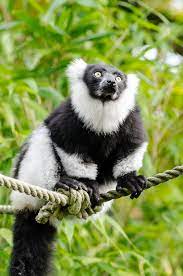Black-and-white Ruffed Lemur Animal
The high contrast ruffed lemur (Varecia variegata) is a
jeopardized types of ruffed lemur, one of two which are endemic to the island
of Madagascar. Notwithstanding having a bigger reach than the red ruffed lemur,
it has a lot more modest populace that is fanned out, living in lower populace
densities and reproductively detached. It likewise has less inclusion and
security in huge public parks than the red ruffed lemur. Three subspecies of
high contrast ruffed lemur have been perceived since the red ruffed lemur was
raised to species status in 2001
Along with the red ruffed lemur, they are the biggest surviving
individuals from the family Lemuridae, going long from 100 to 120 cm (3.3 to
3.9 ft) and gauging somewhere in the range of 3.1 and 4.1 kg (6.8 and 9.0 lb).
They are arboreal, investing the majority of their energy in the high overhang
of the occasional rainforests on the eastern side of the island. They are
additionally diurnal, dynamic solely in light hours. Quadrupedal movement is
liked in the trees and on the ground, and suspensory conduct is seen during
taking care of. As the most frugivorous of lemurs, the eating routine comprises
basically of natural product, in spite of the fact that nectar and blossoms are
likewise preferred, trailed by leaves and some seeds.
The high contrast ruffed lemur has a perplexing social
design and is known for its clearly, rambunctious calls.[6] It is surprising in
that it displays a few regenerative characteristics normally found in little,
nighttime lemurs, for example, a short incubation period, enormous litters and
quick maturation.In imprisonment, they can satisfy 36 years.
Scientific
classification
The highly contrasting ruffed lemur is one of two animal
categories in the class Varecia, the other being the red ruffed lemur (V.
rubra). Three subspecies are perceived: the white-belted highly contrasting ruffed
lemur (V. v. subcincta), the Hill's ruffed lemur, (V. v. editorum), and the
highly contrasting ruffed lemur (V. v. variegata, the designate subspecies).
Portrayal
Close-up of head
Along with the red ruffed lemur, the species is the biggest surviving individual from the family Lemuridae, going long from 100 to 120 cm (3.3 to 3.9 ft) and gauging somewhere in the range of 3.1 and 4.1 kg (6.8 and 9.0 The high contrast ruffed lemur is generally both high contrast; the overall variety designs don't normally differ. Mid-region, tail, hands and feet, inward appendages, temple, face and crown are dark. The fur is white on the sides, back, rear appendages and on the rump. Guys and females are alike.
Dissemination and
natural surroundings
The species possesses the eastern rainforests of Madagascar.
It happens at low to direct elevations, in essential backwoods with tall and
mature trees, and by inclination somewhere inside touching squares of
vegetation, albeit sketchy timberlands are utilized if necessary.
The three subspecies have marginally various reaches. The
white-belted highly contrasting ruffed lemur is seen as farthest toward the
north,the southern highly contrasting ruffed lemur is viewed as uttermost
toward the south, and the high contrast ruffed lemur has a geographic reach
between the other two subspecies.
Diet
Wild high contrast Black and white animal photography have a profoundly frugivorous diet, with natural product making up 92% of their general eating routine. More modest rates of leaves, nectar, seeds, and even organisms make up the rest of. Their eating routine is likewise impacted by the seasons, with specific plant parts and organic products just maturing or opening up during specific seasons. Water utilization additionally fluctuates consistently and can be affected by diet.he quantity of tree species used by for food by the lemurs can go from 19 to 40 species relying upon area. The bigger piece of natural product things in the eating regimen is given by four taxa of organic product trees: Ravensara species, Chrysophyllum boivinianum, Protorhus species, and Harungana madagascariensis.
Female predomnce
High contrast ruffed lemurs show the interesting way of
behaving of female social predominance both inside and outside the setting of
feedings. This is found in other ruffed lemurs as well as in ring-followed
lemurs and red ruffed lemurs. Forceful communications among guys and females
are normally won by the female in any event, when they don't show forceful way
of behaving towards the male. Dissimilar to different types of lemurs, high
contrast ruffed lemur females at times show accommodation and more hostility
should be kept in control for the female to win the connection as opposed to
having an unsure cooperation. Male hostility doesn't fluctuate among
seasons.
One of the primary reasons that high contrast ruffed lemurs
show predominance is for taking care of direction; that is they can lay out
need over guys in taking care of. Regenerative females need more admittance to
food in light of the expenses of conveying and really focusing on posterity
which is the reason they lay out this taking care of need. Energy requests in
this species are especially high. Female predominance in taking care of is kept
up with through showing a forceful way of behaving and driving the gathering to
food to have first admittance to the food. Predominance isn't believed to be
laid out in more youthful females so bunches without a full grown female might
not have a prevailing female. Whenever a prevailing female is available, she
drives the gathering to the food source and eats more than the remainder of the
group.
Correspondence
The high contrast ruffed lemur shows a few different call
types every one of which most recent a few seconds. Most lemurs of a gathering
partake in any one chorale. These lemurs are especially known for their
boisterous thunder/scream chorales which have a few purposes including bunch
development, separating among various gatherings, and disturbing different
individuals from the gathering of hunters. Dissimilar to the calls of different
species, the calls of the high contrast ruffed lemur are not prone to be for
the foundation of region for a gathering. The calling conduct is partaken in
all through a day, not accumulated at any one mark of the day; but calls are
typically not heard at night.
Interspecific connections
High contrast ruffed lemurs are known to frame a
characteristic half and half zone with the red ruffed lemur. This zone might
have once been extremely enormous before people came into contact with the two
subspecies. The calls of the two living beings contrast in recurrence and
heartbeat rate.
adolescent
Social design
Investigations of gatherings of high contrast ruffed lemurs both in imprisonment and in the wild have exhibited an assortment of social designs from matches to huge gatherings. Bunches have been displayed to show a scope of splitting combination elements, implying that gathering size can vacillate in light of asset accessibility. At the point when assets (for example food) are ample, the climate can uphold a bigger gathering of lemurs, yet when assets are scant, the gathering might part into more modest sub-gatherings to get by. The sub-gatherings can rejoin and part on a case by case basis with ecological and social cues.[20] Parenting in this types of lemurs is special in that no single baby is put resources into however all things being equal, females bear litters of numerous posterity. Guys likewise assume a part in the nurturing of the posterity particularly in more modest gatherings where the assurance of paternity is high. In bigger gatherings, the opportunity of a female mating with more than one male increments as does vulnerability in paternity. This will in general diminish the degree of male consideration of posterity. Rather than sticking to the mother, posterity are put into a home which is monitored by the two guardians, depicted exhaustively below.
Propagation
The two guys and females arrive at sexual development
between the times of 1.5 and 3 years, albeit reproducing isn't really fruitful
during the primary year of development. Guys display testicular growth as they
mature, which slowly increments throughout the long term prompting their
rearing window. After effectively rearing with a female, the male's balls step
by step diminish to typical. Whenever females become physically developed and
enter estrus during the rearing season, their vaginas start to open somewhat,
beginning with a little pink spot and line, which is effectively noticeable in
light of the fact that the skin around the vulva is dark. The pink region step
by step opens throughout the span of a few days. When completely opened,
vaginal estrus endures 2-3 days. During this time, there is a significantly
more modest window of time (6-12 hours) when the female is in conduct estrus,
and rearing is just conceivable during this period. Subsequent to reproducing,
the female's vulva step by step closes and stays dark and shut for the rest of
the year. Incubation endures a normal of 102.5 days and regularly brings about
a litter of 2-6 posterity that can't stick to their mom, as in different
primates. The female forms a home where babies stay until they can leave it all
alone. For the initial fourteen days after birth, the female stays with the
newborn children almost 24 hours a day. Both guys and females will
watch the home. There is proof that related as well as inconsequential females
will store their babies in public homes and offer in parental consideration
while others search, bringing about expanded baby endurance contrasted with
single-settling females.
Preservation
Each of the three subspecies of the high contrast ruffed lemur are named Critically Endangered by the IUCN.[26][27][28] The quantities of high contrast ruffed lemurs are on a precarious descending pattern, dropping 80% in the 21 years before 2020, the comparable to three generations.The Vasey concentrates in 2003 showed that Nosy Mangabe is the most thickly populated area of high contrast ruffed lemurs. It had around 29-43 people/km2. Next in diminishing request came Anatanamatazo with 10-15 people/km2, and afterward Manomba with.4-2.5 people/km2.
Dangers in nature
While hunters might be a huge danger to the high contrast
ruffed lemur, the important danger to their endurance comes from the human
occupants of the island. Since they are nearly enormous to different types of
lemurs they are pursued as bushmeat by poachers and town men who are hoping to
take care of their families.[30] Another danger to the lemurs is the rural acts
of the neighborhood local area. The cut and-consume strategy for agribusiness
is exceptionally decimating to the regular natural surroundings of the high
contrast ruffed lemur.[31]
The high contrast ruffed lemur is gone after by the Henst's
goshawk (Accipiter henstii), fossa (Cryptoprocta ferox), ring-followed mongoose
(Galidia elegans) and brown-followed mongoose (Salanoia concolor). Settling
conduct represents the most serious dangers for predation, particularly
mammalian hunters.
Renewed introduction
High contrast ruffed lemurs were essential for a renewed
introduction program from 1997 to 2001, coordinated by the Madagascar Fauna
Group and the Duke University Primate Center (presently Duke Lemur Center). A
sum of 13 people that were brought into the world in human consideration in the
United States were delivered at the Betampona Reserve, which is in their local
reach in the rainforests of eastern Madagascar.[32][33][34] Prior to being
delivered, people were chosen by the ruffed lemur Species Survival Plan in view
of hereditary data, wellbeing status, life history, and social traits.
Every one of the people went through a "training camp" program preceding delivery that gave the lemurs experience in a free roaming normally lush environment.[36] During this time, the lemurs had the option to work on their actual capacities in a timberland shade as well as scrounge for normally developing food. The lemurs were delivered in 3 gatherings, each cotising of a family gathering or matching, to impersonate their regular gathering patterns.
Once delivered into the wild, the creatures each had radio
communicating collars, to help with the examination and observing potential
outcomes post-discharge. The lemurs were furnished with some beneficial food




Comments
Post a Comment